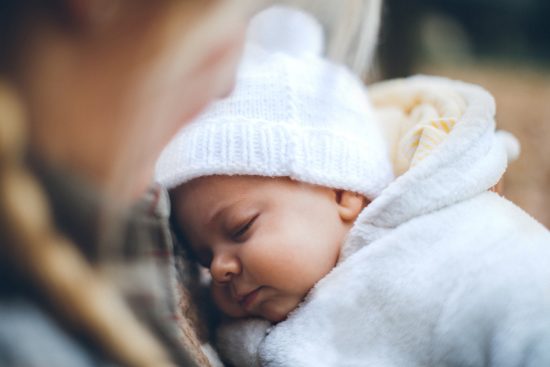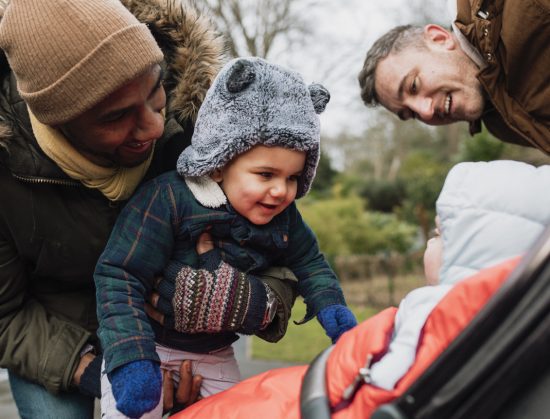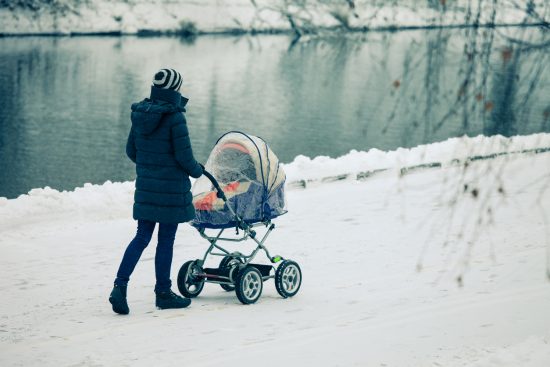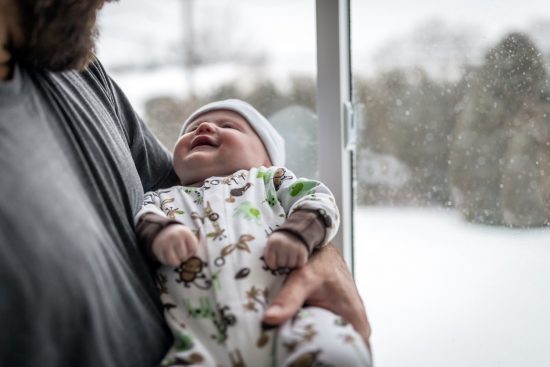From cosy head to toasty toes, we explore what kit you’ll need to get your baby through their first chilly season.
It might take a ridiculously long time to get ready. And your bundle of joy might kick up all manner of fuss as you try to add just one more layer. But my goodness, there is nothing cuter than your baby all wrapped up for their first winter. Here are our tips for keeping warm in the cold.
Just as it’s important to layer-up to go outside, you also need to layer down inside
Literally. Full-on snowsuits are handy for long periods in freezing cold temperatures, but most of the time, adding and removing layers is the way to go. Particularly if you’re going to be nipping in and out of houses, shops or cafes.
It’s a good idea to check what you’re wearing and put them in one more layer. So, if you’re in a shirt, sweater and jacket, your baby might need a vest, sleepsuit, jumper and coat (plus hat and gloves as needed).
But remember, just as it’s important to layer-up to go outside, you also need to layer down inside.
Your baby will be as glad to cool down in a toasty, warm house or café as they were to stay warm in the frosty weather.
NHS advice is to take off a baby’s hat and extra clothing just as soon as you come back indoors or get into a warm car, bus or train. Even if it means waking your baby. We know this seems like the last thing you’ll want to do but it is important to ensure they don’t overheat.

Ok, now for the really cute bit. It’s especially important to keep your baby’s head warm in winter, so be sure to dress them in a woolly or insulated hat. The ones that cover their ears and cheeks are a great idea for maximum warmth and adorability.
Mittens for hands are good too, though it can be tricky to keep them on (to say the least). It’s worth persevering, but remember, little hands can also be tucked under blankets. The most important thing is that your baby’s body and head are wrapped up well to keep the warmth from escaping.
No, not starkers – that really wouldn’t be a good idea. Baby clothes with natural fibres, like cotton and wool are great for winter and help to maintain body heat. They’re comfy, warm, gentle on the skin and let the skin breathe.

Whatever the weather, it’s always a good idea for you and your baby to get out for the fresh air and change of scenery – even if it’s just for a short walk. In fact, babies sleep better at night if they’ve had some fresh air during the day.
While walking is helping keep you warm, your baby isn’t getting the same benefit. The good news is that most buggies and strollers have snuggly bags available for these winter months – what a way to travel.
And remember, if you’re using a sling or carrier, your baby will have that wonderful extra source of warmth – your body. Just be sure to check regularly to make sure they’re not too hot. Look at our article on everything you need to know about slings and carriers.
Sleeping in the fresh air
A Scandinavian method catching on in the UK is the benefits of a baby napping outside in the fresh air. We’re not suggesting you wheel your baby out in a blizzard. But, you both getting out for a walk and them napping al fresco could be of real benefit to them as long as they’re suitably wrapped up.
You might be tempted to buy the cutest little woollen coat but remember to think comfort over adorability. Try to choose clothes that allow your baby to move their arms and legs as easily as possible. And watch for potentially annoying zips right up by their neck. They might prefer a couple of soft, lined cardigans rather than a big stiff coat.

Rain covers for buggies and strollers are invaluable in winter – not only do they keep your baby nice and dry, but they also provide extra warmth. If you’re using a sling or carrier, a good-sized umbrella will do the trick nicely too.
If your baby’s at the crawling stage, it can be wonderful to let them explore the snow for the first time. This is where snowsuits or puddle-suits come into their own – just be sure to check your baby isn’t over-dressed underneath so they don’t overheat.
That’s right, you’ve just added several new layers to the joys of baby-changing. The last thing you want is to have to struggle through them on a cramped toilet floor. Be sure to check out our award-winning Babychange App to help you find your closest changing facilities.
Make friends with other new parents in your local area for support and friendship by seeing what NCT activities are happening near you. You’ll soon get to know which cafes, shops and restaurants will give you, your new friends and your buggies (and babies) a warm welcome.
Check regularly to make sure they’re not overheating
Keep the layers to a minimum when out in the car – this is really important. If there is too much padding between your baby and their car seat straps, the seat will not be safe.
Cars can be icy cold to get into in the wintertime but they soon warm up. And if you’re still worried that your baby’s cold, lay a blanket over them after they’re safely strapped in. But check regularly to make sure they’re not overheating either.

Just like adults, a lot of your baby’s wintertime is spent adjusting to the different temperatures indoors and outside. To check you’ve got the number of layers just right, check their tummy as it’s a much better indicator than their hands.
Tiny hands and feet will inevitably feel cold in cold weather – this is perfectly normal. If they look blue or blotchy, pop on some gloves or extra socks. And if you’re worried, you can always make them nice and toasty again by holding them close.
We all like to throw an extra blanket on when the nights get colder. Yet it’s a good idea to err on the side of a cooler, not warmer, bedroom for your baby. Babies can overheat because their room is too hot or because there is too much bedding or clothing. The ideal temperature is between 16˚C and 20˚C.
The ideal temperature is between 16˚C and 20˚C.
Most of the time, it’s OK to dress your baby in their usual sleep suit. Remember to put them to sleep at the bottom of their cots if you add a blanket. That way they don’t wriggle down underneath them.
If you’re using a sleeping bag, check the manufacturer’s recommendation for winter tog thickness.
Our support line offers practical and emotional support with feeding your baby and general enquiries for parents, members and volunteers: 0300 330 0700.
We also offer antenatal courses which are a great way to find out more about birth, labour and life with a new baby.
Make friends with other parents-to-be and new parents in your local area for support and friendship by seeing what NCT activities are happening nearby.